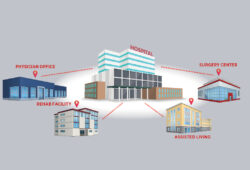Establishing better rules & processes for the well-being of patients & healthcare workers
While it may seem counterintuitive, some of us can still remember when smoking cigarettes was permitted in hospitals. (The Joint Commission banned it from accredited hospitals in 1993.) But if you work in a hospital operating room today, you’ll find that smoke is still a part of the daily work experience. Smoke is created from surgical procedures, and staff and patients subsequently breathe in harmful chemicals and particles that may have the equivalent impact of smoking an entire pack of cigarettes.
Fortunately, organizations are sparking change to protect patients and healthcare workers, and suppliers are improving products to make it a reality.
What is surgical smoke?
Surgical smoke is produced when devices such as electrosurgical units, lasers and ultrasonic devices are used on body tissue to dissect or ablate tissue, or provide hemostasis. Surgical smoke occurs in hospitals, ambulatory care centers, clinics and doctors’ offices.

“When a surgeon uses one of these devices to cut or dissect human tissue, it creates a plume of smoke,” says Marty Higgins, MS, RN, CNOR, Service Line Director of Perioperative Services at CHRISTUS Health. “The issue is what’s in that plume.”
How surgical smoke is harmful
Some particles in surgical smoke are proven to be carcinogenic.
According to a 2012 study published in the Journal of Plastic, Reconstructive & Aesthetic Surgery, spending one day working in an OR can have the same effect as smoking up to 27 cigarettes.
We don’t yet know the impact of surgical smoke on healthcare workers, as more research is needed. In the last few years, though, institutions like the Association of periOperative Registered Nurses (AORN) and Stryker, a large medical device manufacturer, have been examining the harmful elements of surgical smoke. Take HPV virus, for example. As the virus is surgically lasered off a patient, the virus particles are released into the plume of smoke, which is then inhaled by the people in the OR. Staff members wear surgical masks, but those don’t adequately filter out the smoke particles. “Any particle that is less than 10 microns can be considered irritating to the lungs,” explains Higgins.
Research cited by AORN indicates that perioperative nurses report respiratory problems such as allergies, sinus infections, asthma and bronchitis at twice the rate as the general population.
A responsibility of protection

One strategy that healthcare systems can take to promote a safer perioperative work environment is through widespread implementation of a surgical smoke evacuation system. “Healthcare organizations have a responsibility to protect patients and staff and should have a policy in place regarding the use of smoke evacuation systems,” says Jennifer Westendorf, MSN, RN, CNOR, Director of Surgical Services for HealthTrust.
However, she explains, historically there may have been multiple barriers preventing a hospital’s ability to transition to a smoke-free environment. Some of these barriers may have been related to the cost of smoke-free devices, the limited number of smoke evacuation systems on the market, the amount of noise they generate and that the devices themselves are somewhat bulky.
But the embers are burning for change. “The emergence of COVID-19 placed a national spotlight on surgical smoke like never before,” says Westendorf. “It has generated a sense of urgency to protect patients and healthcare workers.”
Improving products
Some surgical smoke evacuation systems are designed to evacuate smoke from an open procedure, while others are designed for minimally invasive procedures. They work by sucking out the smoke like a vacuum cleaner, with filtration that removes odor, poisonous gases and smoke particles from the air during surgical procedures.
Some devices have smoke evacuation options where you only need to add filters, so you don’t have to purchase a different piece of equipment. One example is Stryker Neptune, which has a fluid management system as well as smoke evacuation capabilities in one piece of equipment. At CHRISTUS Health, about 85% of ORs have the Neptune, so adding the filter and handpiece is the only additional expense.
“While these smoke evacuation systems improve the situation, the healthcare industry is still in the early stages of adoption,” says Higgins.
HealthTrust has multiple suppliers on contract to ensure that hospitals can select the smoke evacuation system that best meets their clinical and operational needs.
Legislative & grassroots efforts
AORN has been a longtime advocate for a smoke-free environment and is leading the charge to ensure that ORs across the country are smoke-free by law. While there is no federal mandate to reduce surgical smoke, 26 states have passed legislation since 2018. In August 2021, AORN launched a national petition to put pressure on the U.S. Occupational Safety and Health Administration (OSHA) to issue regulations requiring worker and patient protections from harmful surgical smoke. In October 2021, AORN released its latest guideline for surgical smoke safety, which provides recommendations to healthcare organizations on establishing a safe environment for both surgical patients and team members.
“AORN has a really robust guideline, and it also provides a variety of toolkits and resources to assist hospitals in developing policies and practices that will promote a safer working environment for their perioperative teams and patients,” says Westendorf.
Higgins has been working with her health system leadership to increase awareness of the situation at hand. “Operating room staff may not yet be aware of this issue, but there will come a time when they are,” she says. She believes this issue may look different in as soon as two years, as more states pass legislation and recommendations become more defined.
“I think what you will see in the coming months is increased awareness and increased action,” says Higgins. “Hospitals don’t need to have state legislation or an agency mandate to do the right thing, which is to take care of their patients and staff by providing appropriate smoke evacuation. The biggest movement will come from grassroots efforts of OR directors explaining to their C-suite executives that this is the right thing to do.”
Share Email OR, Q1 2022, Regulations, Surgery





